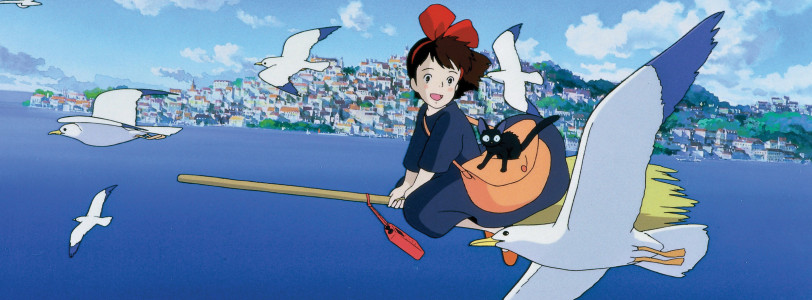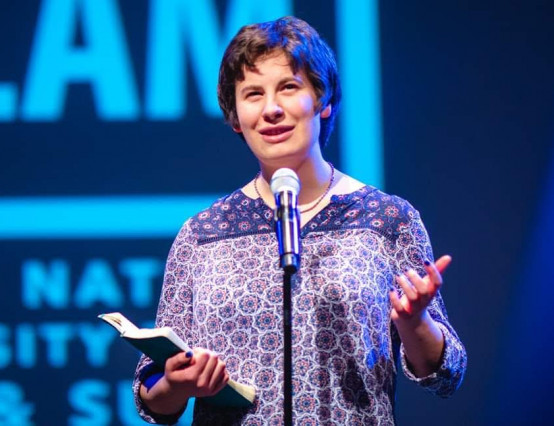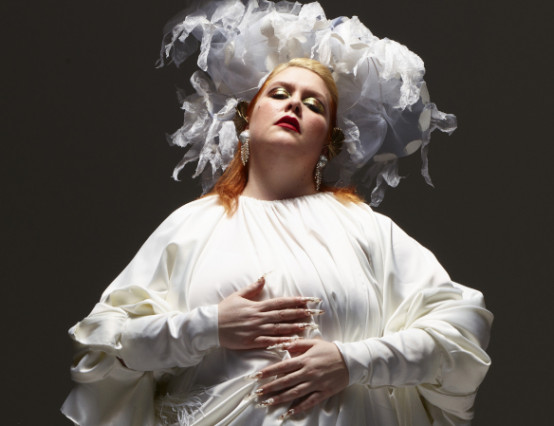My first introduction to the immersive realms of Hayao Miyazaki’s Studio Ghibli films happened when I was eight years old. These animated films were expansive, dreamy, and the storytelling spoke to me in ways that not many filmmakers had. Since then, I have made it a mission to marathon all the films every single year because, despite the countless times I have seen these films, it feels like seeing them with fresh eyes.
Now, there are 24 of them, which can be somewhat daunting when trying to begin your enchanting journey throughout the Ghibli universe. Should you watch them in chronological order? Should you watch the critics' favourites? Here are my top 10 Ghibli films that you should watch first to get you started.
10. My Neighbour Totoro (1988)
As the face of Studio Ghibli, My Neighbour Totoro had to appear somewhere on this list. Satsuki and her sister Mei move with their father to a new countryside home, but there is more beneath the surface. The two sisters soon find that their own house and surroundings are full of strange creatures, like wandering soot sprites ‘susuwatari’ and a cat bus. The two befriend Totoro, a gigantic yet gentle forest spirit who leads the two sisters’ adventures.
My Neighbour Totoro is cram-packed full of iconic Studio Ghibli scenes, like Totoro and the sisters with their umbrellas at the bus stop or sitting on a branch over a body of water. This film evokes a sense of childhood nostalgia, which means it can become somewhat of an emotional watch. However, as Totoro is the cover model for the studio, it probably means that you should watch it just to see his toothy grin and midday snoozes.
9. Grave of the Fireflies (1988)
Nothing is as emotional as Grave of the Fireflies. I said it, and I’ll say it again: it's Studio Ghibli’s saddest film. Tears. Rivers. Floods. You’ll need a stock of tissues at your side to finish this.
It is one of the most powerful anti-war films, set in the background of the final months of the Second World War. Two siblings, Seita and Setsuko, struggle to survive – they were in the wrong place at the wrong time, and now the two children fend for themselves as bombs fall upon Japan. It is as harrowing as it is horrifying, but ultimately it is a story about the human spirit which does set off the waterworks. Watch this to see Studio Ghibli’s most sensitive and simultaneously brutal story.
8. Princess Mononoke (1997)
If you’re looking for a purely badass film with some of the best action sequences in animation history, then turn to Princess Mononoke.
It is an epic fable about a young warrior, Ashitaka, who is inflicted with a deadly curse and seeks its cure from a deer-like god named Shishigami. Ashitaka soon becomes tangled up in a conflict involving humans and spirits. He witnesses humans destroying the earth, and brutally murdering spirits and gods. He soon meets a young girl raised by wolves named Princess Mononoke who ferociously protects her home to protect the forest spirit and animal god inhabitants that reside there.
It is a story of conflict, man versus nature – something all too familiar in today’s climate. However, this film ties in Eastern philosophy, balancing both good and evil which makes it an unpredictable and dynamic watch.
7. Porco Rosso (1992)
In and above the Adriatic Sea’s port town, Porco Rosso is a well-worn bounty hunter with the face of a pig following an unusual curse. Porco takes an aspiring aeroplane designer called Fio under his wing and prepares for his final flying showdown. Porco Rosso heavily features aeroplanes that are handled with respect and care, and it is magical to witness scenes where seas of planes fly overhead as they dance and battle each other.
Taking place in the aftermath of World War I, it uniquely meshes reality and fantasy. It’s a complex film, and Miyazaki is resistant to the traditional conventions of a fairytale so it takes unexpected directions which is refreshing. Ultimately it is a tale about personal change, that we don’t need to see a physical exterior change to unveil an internal one. It’s a more laid back film than the previous, so sit back and relax as Porco Rosso takes you on an incredible journey both on land and above it.
6. Pom Poko (1994)
When people think of tanuki (Japanese raccoon dogs) you’d think they’d be adorable, inspiring general awe from an audience by their appearance, fairly one-note in that respect. However, Pom Poko reimages the tanuki in a tale about human-led environmental destruction. In a Tama Hills tribe of shape-shifting tanuki, they find their easy-going community attacked by incoming developers who seek to create more houses and shopping malls. In a bid to survive, they hitch a plan to drive the developers out.
It's a modern tale, about human intrusion into nature, how brutal this invasion of natural space can be to those who call it their home, and how nature is being harmed under our noses. What is most interesting about this film is the diversity of thought that the tanuki community has. Some try to reach out to the humans to get them to understand their side of the story, others look to the sacred art of transformation, and a few turn to extremism and decide that they must kill all humans in retaliation. The film evokes the question of: how do we band a split community together to inspire change?
5. Howl’s Moving Castle (2004)
With Howl’s Moving Castle, you find yourself immersed within a fan-favourite storyline between a mysterious wizard named Howl and a quiet girl called Sophie. What’s the issue with Sophie? You guessed it, another curse. Sophie is cursed by the envious Witch of the Waste into a 90-year-old woman. On a quest to break this wicked spell, Sophie joins Howl in his wonderful moving castle.
The art in this film is some of Studio Ghibli’s best. The visual architecture is a delight for the eyes. Howl's Moving Castle is full of quirky and eccentric intricacies that you’ll continue to discover even after multiple viewings. The morals of the story are also beautiful. Firstly, that love makes you young regardless of physical ailments. Then there is also the existence of Howl as a person with many masks and heaps of emotional baggage manifested into this gigantic castle, it’s a story about acceptance, humanity and love.
4. The Cat Returns (2002)
At only a 75 minute running time, this small digestible film is perfect for a rainy day. If you love cats, you’re in for more than a treat. There is a whole kingdom full of them waiting to meow at you.
The story follows the schoolgirl Haru who saves a cat from oncoming traffic. However, as with Studio Ghibli tradition, events begin to take a bit of a strange turn. Haru sees the cat she saved walking on its hind legs and politely thanks her, to find later on that crowds of cats begin to follow her and that her physical appearance becomes more feline-like. By a decree from the King of Cats, Haru is entered into an engagement with the cat she saved, the Prince of the Cat Kingdom. With the help of her talking animal friends Baron, Toto and Muta – the film follows her trying to get back home to familiarity, and believe in herself to do so.
Shoutout to Muta, the best cat whom everyone should just watch this film for. There’s a lot of joy to be gained from the moody Muta.
3. Spirited Away (2001)
Whilst I would argue that a lot of Studio Ghibli films are masterpieces in their own right, Spirited Away is the one that holds the most critical acclaim. Now, this wondrous fantastical film is the most difficult to describe as it is difficult to serve the visually stunning story justice through words alone.
You can see why it won the Academy Award for ‘Best Animated Feature’ in 2003 within the first five minutes. A car ride with a young girl Chihiro in the backseat whilst her parents navigate off-roads only to find themselves quite lost. It is a small taster sample of the chaotic and wild journey Chihiro will find herself independently navigating further on in the film.
Watching Chihiro in Spirited Away step into the spiritual world of Kami, abandoning all of the reason found in reality and finding herself suspended in a fantastical setting, felt a lot like diving into it with her. In this film, we are transported away to a magical bathhouse for spirits and demons, meet a powerful sorceress Yubaba, and encounter the iconic ‘No-Face’. The title is incredibly fitting for the film, we are truly spirited away into this new vibrant and somewhat haunting new world through the eyes of a young girl without her parents there to guide her where to go.
2. The Tale of the Princess Kaguya (2013)
Based on the 10th-century Japanese folk story called ‘The Tale of the Bamboo Cutter’, The Tale of the Princess Kaguya tells the story of a poor couple who find a baby in a bamboo shoot and decide to raise their little miracle as a princess. Directed by Isao Takahata (Grave of the Fireflies, My Neighbours the Yamadas), who never trained as an animator, it is a slow-paced film that isn’t an expansive epic fantastical world like Miyazaki’s films. Instead, it is relatively simple and mundane. That’s what makes it beautiful, the simplicity of it all elevates the themes of ambition versus humanity.
The art style is distinctive, it looks as if it is a hand-drawn watercolour painting. The animation is based on traditional Sumi-e watercolour paintings, using confident long strokes and muted colours to represent calm. At times of struggle or frustration, the art style turns noticeably darker with greyscale with hints of red, and the technique turns to jagged quick lines that represent the inability to control the stressful situation at hand.
When I watch The Tale of the Princess Kaguya the expressive technique of the animation tells the story. Takahata tells it with such graceful attention to detail, that the simplicity of the story allows viewers to feel so emotionally invested with the characters involved. Definitely, one where you’ll need some tissues for your tears.
1. Kiki’s Delivery Service (1989)
Last but not least, we have arrived at the diamond in the rough that is Kiki’s Delivery Service. Now, I have a lot of childhood nostalgia attached to this film which might make me a touch biased – but truthfully, it is a film that everyone should at least watch once in their lives.
It is a mundane story, about a resourceful young witch who takes a gap year. Kiki follows tradition and leaves home on the night of a full moon to learn more about her craft. Alongside her cat, the sarcastic and sassy Jiji, Kiki’s abilities dazzle seaside villages and she decides to make her delivery service. That is until she experiences a handful of delivery-related and social failures that begin to lower her self-esteem.
What this story tells us is that we should never give up, that failure is an intrinsic part of success. Essentially, it’s a story about burnout. Kiki begins losing her powers due to it, and the actual journey is her realising her power and reclaiming it back on her own terms.









0 Comments